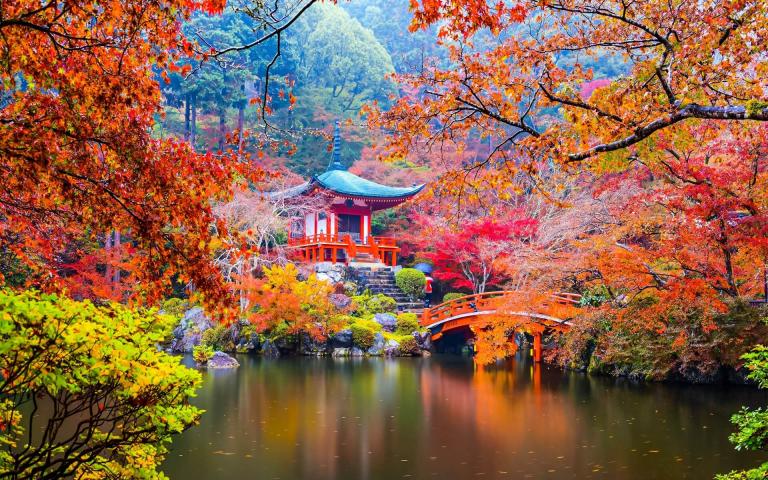Discover the vibrant nightlife scenes of Europe's most fascinating cities and travel to remember-able destinations! From the vibrant beauty of London to the thrilling energy…


Kyoto, a city of considerable historical importance and cultural wealth, is located in the Kansai area of Honshu, Japan’s biggest and most populated island. In 2020, this dynamic metropolis had a population of 1.46 million residents, making it the ninth-most populated city in Japan. Notably, over half of Kyoto Prefecture’s inhabitants, precisely 56.8%, dwell in the city. Kyoto is the cultural foundation of the extensive Greater Kyoto metropolitan statistical region, which has around 3.8 million inhabitants. Moreover, it is a vital component of the more expansive Keihanshin metropolitan region, which includes the notable cities of Osaka and Kobe.
The establishment of Kyoto as a center of authority started in 794 CE when Emperor Kanmu designated it as the new site for Japan’s royal court. This decision signified the establishment of one of Japan’s oldest municipalities, originally named Heian-kyō. The city’s design was carefully orchestrated following traditional Chinese feng shui principles, inspired by the ancient capitals of Chang’an and Luoyang. This deliberate urban planning established the foundation for Kyoto’s lasting importance in Japanese history and culture.
For eleven centuries after its founding, Kyoto served as the imperial capital of Japan and the residence of the emperors until 1869. Throughout this protracted duration, the city experienced several crucial events that influenced the trajectory of Japanese history. The Muromachi period, marked by the governance of the Ashikaga shogunate, positioned Kyoto as the focal point of political and cultural advancements. The city thereafter emerged as a center of conflict throughout the Sengoku period, characterized by severe civil war and societal disruption.
One of the most significant historical events that occurred in Kyoto was the Ōnin War (1467-1477), a struggle that initiated the Sengoku era and resulted in extensive devastation in the city. The Honnō-ji Incident of 1582, in which the formidable daimyō Oda Nobunaga perished, reverberated throughout Japan’s political landscape. The Kinmon Incident of 1864, an unsuccessful revolt by imperial loyalists against the Tokugawa shogunate, highlighted Kyoto’s significance in the turbulent events preceding the Meiji Restoration. The 1868 Battle of Toba-Fushimi, a pivotal engagement in the Boshin War, signified the start of the decline of the Tokugawa shogunate and facilitated Japan’s modernization.
The Meiji Restoration resulted in substantial transformations for Kyoto, since the imperial capital was transferred to Tokyo in 1869. The transition in governmental authority may have indicated a downturn for several towns; nonetheless, Kyoto’s profound cultural significance guaranteed its sustained prominence. The present municipality of Kyoto was officially founded in 1889, initiating the city’s development in the modern era.
A notable part of Kyoto’s contemporary history is its remarkable preservation throughout World War II. In contrast to several Japanese cities that experienced significant devastation due to Allied bombing raids, Kyoto was predominantly exempt from substantial harm. This advantageous situation enabled the city to save a significant portion of its prewar cultural history, safeguarding centuries-old temples, shrines, and traditional architecture for future generations to admire and examine.
Currently, Kyoto is recognized as the preeminent cultural center of Japan, attracting millions of people both domestically and internationally each year. The city’s appeal is in its distinctive fusion of traditional customs and contemporary advancements, providing insight into Japan’s illustrious history while concurrently welcoming the future. The Japanese government officially acknowledges its cultural value, with the national Agency for Cultural Affairs located inside the city borders.
The environment of Kyoto has a remarkable collection of Buddhist temples, Shinto shrines, royal palaces, and well-maintained gardens. A number of these places have been jointly recognized as a UNESCO World Heritage Site, signifying their exceptional global value and significance to human history and culture. The city’s most iconic landmarks include the Kyoto Imperial Palace, emblematic of its imperial heritage; Kiyomizu-dera, a Buddhist temple celebrated for its wooden terrace with sweeping city vistas; Kinkaku-ji, the illustrious Golden Pavilion that appears to hover over a serene pond; and Ginkaku-ji, the Silver Pavilion, distinguished by its elegant architecture and zen gardens.
Although profoundly anchored in tradition, Kyoto is not mired in antiquity. The city hosts Nintendo, a globally renowned and pioneering video gaming corporation. The contrast between old temples and advanced technology embodies Kyoto’s distinctive identity as a city that respects its tradition while adopting modernity.
Education is integral to Kyoto’s character and ongoing cultural significance. The city serves as a prominent hub of higher education in Japan, accommodating several universities and research organizations. Established in 1897, Kyoto University is the second-oldest university in Japan and constantly ranks among the world’s premier intellectual institutions. Its existence substantially enhances the city’s intellectual environment and research productivity.
Kyoto is situated in a unique location within the Japanese topography. The city is situated in a valley inside the Yamashiro Basin, commonly referred to as the Kyoto Basin. This basin is bordered on three sides by mountains: Higashiyama to the east, Kitayama to the north, and Nishiyama to the west. The surrounding peaks, ascending to nearly 1,000 meters above sea level, provide a natural amphitheater that has influenced the city’s growth and environment over millennia.
The terrain of Kyoto significantly influences its climatic patterns. The city has sweltering summers and frigid winters, a trait of its deep location within the rugged Tamba highlands. This climate fluctuation enhances the city’s seasonal allure, from the vivid cherry blossoms of spring to the intense foliage of fall.
Three principal rivers traverse the Yamashiro Basin, each influencing Kyoto’s topography and historical evolution. The Uji River to the south, the Katsura River to the west, and the Kamo River to the east have historically functioned as essential rivers for transportation, agriculture, and industry. The rivers, together with several smaller streams and canals, have influenced the city’s configuration and significantly contributed to its cultural traditions and celebrations.
Kyoto City encompasses a significant section of Kyoto Prefecture, accounting for 17.9% of the prefecture’s total land area. The city has an area of 827.9 square kilometers, offering a varied urban landscape that harmoniously blends with the adjacent natural surroundings. The seamless integration of urban growth and natural beauty exemplifies Kyoto’s urban planning concept.
Kyoto’s natural advantage lies in its location above a substantial natural aquifer. This geological feature has traditionally supplied the city with a plethora of freshwater wells, enhancing its sustainability and development. Nonetheless, the rapid urbanization of recent decades has posed problems to this natural resource. The proliferation of impermeable surfaces and urban development has resulted in diminished precipitation infiltration, leading to a heightened rate of well depletion throughout the region. This scenario underscores the intricate equilibrium between urban expansion and ecological preservation that Kyoto, akin to several historic cities, must traverse in the 21st century.
Currency
Founded
Calling code
Population
Area
Official language
Elevation
Time zone
Japan, an island nation located off the eastern coast of Asia, with a population of around 124 million as of 2024, ranking it as the ninth most populated country globally. This archipelagic nation consists of four principal islands and several…
Fukuoka, the sixth-largest city in Japan and the seat of Fukuoka Prefecture, is a dynamic metropolis located on the beaches of Hakata Bay on the northern coast of Kyushu Island. Fukuoka, with a population of over 1.6…
Aomori, the capital of Aomori Prefecture, exemplifies the rich heritage of Japan’s northern border. Aomori, located near the northernmost extremity of Honshu, Japan’s largest major island, holds tremendous value due to its geographical location and cultural relevance. As…
Beppu, a city in Ōita Prefecture on the island of Kyushu, Japan, boasts a population of 113,045 residents as of November 30, 2023. With 62,702 households spread across its 125.34 square kilometers, Beppu…
Hakone, an idyllic town located in Kanagawa Prefecture, Japan, with a population of 10,965 as of October 1, 2023, encompassing an area of 92.82 square kilometers. This appealing location has attracted much…
Home Located in the center of Gifu Prefecture, Japan, is the captivating city of Gero. As of October 31, 2017, Gero has an estimated population of 33,283 and a population density of 39 individuals per…
Kusatsu, located in Gunma Prefecture, Japan, has a population of 6,255 individuals residing in 3,407 households as of September 2020, resulting in a population density of 130 individuals per square kilometer.…
Matsuyama, the capital of Ehime Prefecture, is the largest metropolitan center on Shikoku Island in Japan. As of October 1, 2022, this dynamic metropolis has an estimated population of 505,948 inhabitants, spread among 243,541…
Noboribetsu, situated in the Iburi Subprefecture of Hokkaido, Japan, has an estimated population of 49,523 as of September 2016, resulting in a population density of 230 people per square kilometer. This enchanting location, situated…
Furano, an idyllic city located in central Hokkaido, Japan, exemplifies a harmonious fusion of natural splendor, cultural depth, and agricultural excellence. Located in the southern part of Kamikawa Subprefecture, Furano has a population of over 22,715 inhabitants as…
Yokohama, Japan’s second-largest metropolis by both population and size, exemplifies the country’s rapid modernization and its lasting ties to the global community. Located on Tokyo Bay, south of the capital, Yokohama has a population of 3.7 million as of 2023,…
Hakuba (白馬村, Hakuba-mura), a hamlet located in Nagano Prefecture, Japan, with a population of 9,007 as of April 1, 2019, distributed across 4,267 families. This scenic village, with a population density of 48 individuals per…
Hiroshima, a city of considerable historical importance and notable resilience, exemplifies human perseverance and the quest for peace. Hiroshima, located on the scenic delta of the Ōta River in western Japan, serves as the capital of Hiroshima Prefecture and is…
Nagasaki, a city of considerable historical importance and cultural depth, is located on the western coast of Kyushu, Japan’s third-largest island. As of February 1, 2024, this dynamic metropolitan center has an estimated population of 392,281, with…
Nagoya, the fourth most populous city in Japan, exemplifies the country’s industrial strength and cultural legacy. Located in the Chūbu area along the Pacific coast of central Honshu, this city has a population of around 2.3 million as of 2020. Nagoya’s strategic…
Osaka, a dynamic metropolis located in the Kansai region of Honshu, Japan, is the third most populous city in the country, with a population of 2.7 million according to the 2020 census. This vibrant…
Nozawaonsen is a scenic town located in the hilly region of Nagano Prefecture, Japan, with a population of around 3,653 inhabitants distributed among 1,395 families as of April 1, 2019. This charming locality,…
Sapporo, the capital of Hokkaido Prefecture and Ishikari Subprefecture, exemplifies Japan’s northern boundary. As of July 31, 2023, the city has a population of 1,959,750 persons, making it the fifth most populated city in…
Tokyo, the dynamic metropolis of Japan, exemplifies human inventiveness and cultural wealth, with a population exceeding 14 million as of 2023. This extensive city, officially termed the Tokyo city, is not only…
Located in Nikkō, Tochigi Prefecture, Japan, Kinugawa Onsen exemplifies the lasting appeal of traditional Japanese hot spring resorts. This scenic location, positioned along the Kinugawa River, has been a preferred refuge for individuals seeking relief from the…
Discover the vibrant nightlife scenes of Europe's most fascinating cities and travel to remember-able destinations! From the vibrant beauty of London to the thrilling energy…

While many of Europe's magnificent cities remain eclipsed by their more well-known counterparts, it is a treasure store of enchanted towns. From the artistic appeal…

From Rio's samba spectacle to Venice's masked elegance, explore 10 unique festivals that showcase human creativity, cultural diversity, and the universal spirit of celebration. Uncover…

From Alexander the Great's inception to its modern form, the city has stayed a lighthouse of knowledge, variety, and beauty. Its ageless appeal stems from…

Millions of visitors come to Spain annually because of its vibrant culture, fascinating past, and amazing scenery. Still, the real spirit of Spain is found…

© All Rights Reserved. By Travel S Helper